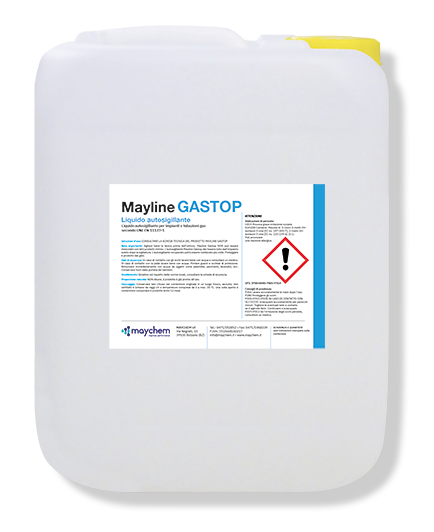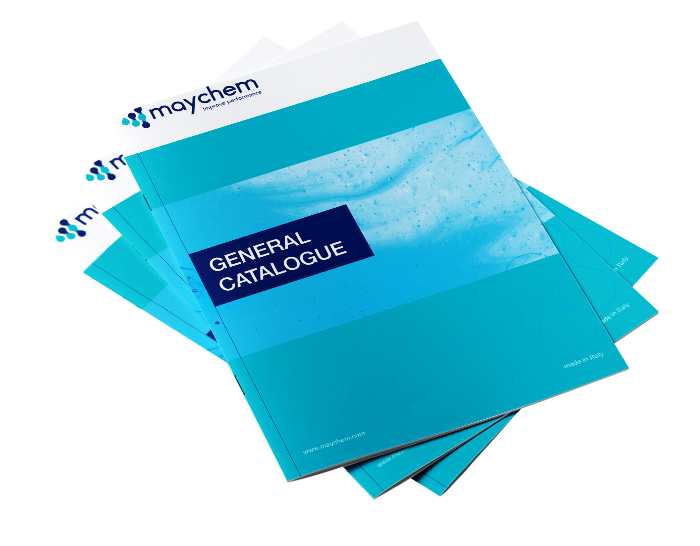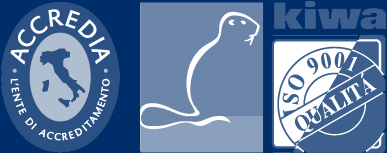Description
Code | Package: 10/MYGAST | 10 kg canister
20/MYGAST | 20 kg canister
20/MYGAST | 20 kg canister
Important note: Shake the container well before use. Mayline Gastop can NOT be mixed with other chemical products. Once the sealing process has been completed, the Mayline Gastop self-sealing liquid must be immediately removed from the system. The recovered product can be reused various times. Protect the product from frost.
Instructions for use: 1. PIPE INSPECTION
Uninstall the counter and the gas device. Install stoppers on the ends of all the lines. Even the blind pipe plugs which are still under pressure must be uninstalled and replaced with a stopper. Do not over-tighten the fittings.
2. LEAK INSPECTION IN COMPLIANCE WITH THE CURRENT LEGISLATION European law requires for gas installations to be free of leaks and the inspection methods are provided in the relative regulations. A digital manometer can be used for the inspection.
3. PRESSURE CHECK In order to check the pressure, the gas installation must be pressurised to 3 bar for about 3 - 5 minutes. This helps to identify any eventual damage due to unseen corrosion while preventing significant quantities of sealant from leaking out while the pressurised pipe is being fi lled.
4. SYSTEM CLEANING In order to remove any eventual dust, rust or other deposits from the gas pipes, a braided drainage hose must be connected near the counter, at the lowest point of the system, and fed into a collection filter, preferably outdoors. The lines must be cleaned out using nitrogen (or compressed air), blowing from all of the ends until the system is completely purged and no more dust or fi l comes out.
5. FILLING WITH SELF SEALING LIQUID The line must be fi lled from the lowermost point towards the uppermost. The Gastop certified membrane pump tool, with nitrogen and compressed air functionality, must be used to fi ll the line (make sure that enough Mayline Gastop self-sealing liquid is available). The gas circuit must be carefully bled, starting at the lowermost point, with the stoppers installed in place of the counter, or rather the point nearest to the gas supply point, and moving towards the uppermost or most distant point in the system. Once fi lling has been completed, bring the system to a pressure of 3 bar, plus 1 bar for every 10 metres in height of the line to be sealed (pressure of 3 bar at the uppermost point), in order to compress the sealant into the threaded joints. For optimal sealing results, be sure to use exclusively Gastop certified instrumentation. In order to maintain a constant pressure during the 2 hours required for the sealant to set, a 1 or 2 litre volume nitrogen cushion must be installed at the uppermost point of the system in order to allow for the possibility of expansion (maximum 3 bar).
6. EMPTYING THE SELF-SEALING LIQUID Slowly release the pressure in the line. Empty the line from the lowermost stopper, by opening the appropriate valves, and collect the liquid. Blow the self-sealing liquid out of the pipe with nitrogen or com pressed air, starting from the uppermost point and working towards the lowermost point. Repeat the operation for all of the joints: all of the points of the line must be cleaned.
7. INSERTING OF MOLCH BALLS Once no more sealant comes out, special MOLCH balls must be inserted into the lines. The diameter of the balls must be at least 10% greater than the largest diameter of the line (max. twice the diameter). The molch balls must be inserted into the terminal points of the gas lines and blown into the lines using nitrogen or compressed air; in this manner, the molch balls push the sealant ahead of them, moving it towards the recovery container. The procedure must be repeated at least two times in order to remove all of the remaining product. The procedure may have to be repeated various times based on the actual necessities. The recovered product can be reused various times. Dirty product can be cleaned using a filter.
8. DRYING The drying procedure is performed using the Mayline Gastop “blower” instrument. Connect the discharge terminals to the ½” tubes, place them in buckets so as not to dirty the floor and proceed with the drying procedure. Install the blower so that it is unhindered, with no obstacles blocking its suction lines. In the event of loss of power, check the filter. Use the air to dry the system, then check the air tightness of the system according to the current legal standards. The system must be free of leaks and no putties or other means must be used to seal it.
9. TESTING THE GAS PIPES SYSTEM After the testing has been completed, the system can be re-commissioned according to the current standards.
2. LEAK INSPECTION IN COMPLIANCE WITH THE CURRENT LEGISLATION European law requires for gas installations to be free of leaks and the inspection methods are provided in the relative regulations. A digital manometer can be used for the inspection.
3. PRESSURE CHECK In order to check the pressure, the gas installation must be pressurised to 3 bar for about 3 - 5 minutes. This helps to identify any eventual damage due to unseen corrosion while preventing significant quantities of sealant from leaking out while the pressurised pipe is being fi lled.
4. SYSTEM CLEANING In order to remove any eventual dust, rust or other deposits from the gas pipes, a braided drainage hose must be connected near the counter, at the lowest point of the system, and fed into a collection filter, preferably outdoors. The lines must be cleaned out using nitrogen (or compressed air), blowing from all of the ends until the system is completely purged and no more dust or fi l comes out.
5. FILLING WITH SELF SEALING LIQUID The line must be fi lled from the lowermost point towards the uppermost. The Gastop certified membrane pump tool, with nitrogen and compressed air functionality, must be used to fi ll the line (make sure that enough Mayline Gastop self-sealing liquid is available). The gas circuit must be carefully bled, starting at the lowermost point, with the stoppers installed in place of the counter, or rather the point nearest to the gas supply point, and moving towards the uppermost or most distant point in the system. Once fi lling has been completed, bring the system to a pressure of 3 bar, plus 1 bar for every 10 metres in height of the line to be sealed (pressure of 3 bar at the uppermost point), in order to compress the sealant into the threaded joints. For optimal sealing results, be sure to use exclusively Gastop certified instrumentation. In order to maintain a constant pressure during the 2 hours required for the sealant to set, a 1 or 2 litre volume nitrogen cushion must be installed at the uppermost point of the system in order to allow for the possibility of expansion (maximum 3 bar).
6. EMPTYING THE SELF-SEALING LIQUID Slowly release the pressure in the line. Empty the line from the lowermost stopper, by opening the appropriate valves, and collect the liquid. Blow the self-sealing liquid out of the pipe with nitrogen or com pressed air, starting from the uppermost point and working towards the lowermost point. Repeat the operation for all of the joints: all of the points of the line must be cleaned.
7. INSERTING OF MOLCH BALLS Once no more sealant comes out, special MOLCH balls must be inserted into the lines. The diameter of the balls must be at least 10% greater than the largest diameter of the line (max. twice the diameter). The molch balls must be inserted into the terminal points of the gas lines and blown into the lines using nitrogen or compressed air; in this manner, the molch balls push the sealant ahead of them, moving it towards the recovery container. The procedure must be repeated at least two times in order to remove all of the remaining product. The procedure may have to be repeated various times based on the actual necessities. The recovered product can be reused various times. Dirty product can be cleaned using a filter.
8. DRYING The drying procedure is performed using the Mayline Gastop “blower” instrument. Connect the discharge terminals to the ½” tubes, place them in buckets so as not to dirty the floor and proceed with the drying procedure. Install the blower so that it is unhindered, with no obstacles blocking its suction lines. In the event of loss of power, check the filter. Use the air to dry the system, then check the air tightness of the system according to the current legal standards. The system must be free of leaks and no putties or other means must be used to seal it.
9. TESTING THE GAS PIPES SYSTEM After the testing has been completed, the system can be re-commissioned according to the current standards.
Safety informations: In the event of eye contact, rinse eyes thoroughly with much water and consult a doctor. In the event of skin contact, rinse well with water. Wear gloves and protective eyewear. Use water to immediately remove the product from objects such as tiles, flooring, wash basins, etc. Keep out of reach of children!
Mixing proportions: Refer to the material safety data sheet (MSDS)
Mixing proportions: DO NOT DILUTE. The product comes ready for use.
Transport: The product is not hazardous for transport. The indications are provided based on actual experience. Technical changes are possible.
Disposal: For information concerning waste disposal/effluent, please consult the corresponding safety data sheet.
Shelf life: Shelf life 2 years (from date of manufacture)




